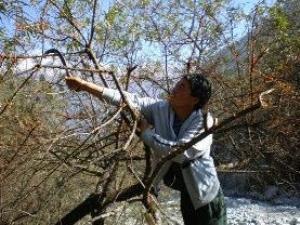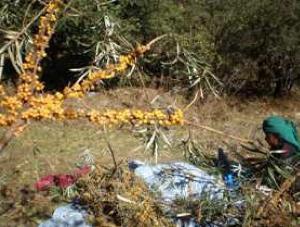Rajesh Rajchal
This project will be implemented in Mustang, a geographically fragile mountain area and will explore the biophysical and socio-economic information necessary to effectively manage the seabuckthorn forest.

A local harvesting seabuckthorn fruit.
Seabuckthorn (Hippophae salicifolia) is vital species especially for mountain-rural poor and possesses unique characteristics that contribute both in environment conservation and socio-economic well-being. However it is one of the least known, unexplored and improperly utilized plant species in Nepal Himalayas prone to the degradation of mountain ecosystem. This project will be implemented in Mustang, a geographically fragile mountain area and will explore the biophysical and socio-economic information necessary to effectively manage the seabuckthorn forest. The project has specifically four objectives:

Seabuckthorn berry collection for weighting and weighting seabuckthorn wood.
Current harvesting procedures and levels are detrimental to the sustainable production of seed and regeneration of seabuckthorn in Mustang district. So, to quantify the allowable harvesting amounts, the first objective is to estimate the standing biomasses of wood, fruits and foliage of seabuckthorn (Hippophae salicifolia).
There is an important contribution of seabuckthorn to the livelihood of rural people but it has not yet been assessed because of which the local people have not gained as much benefits as they could get. So, the second objective is to identify the contributions of seabuckthorn to the livelihood of the local people in Mustang district.
The third objective is to assess the current management systems regarding their techniques of propagation, harvesting, extraction and utilization of seabuckthorn to recommend the appropriate (scientific and socio-economic) management systems.
To enhance the community based management system, the fourth objective is to form a seabuckthorn management committee (SMC), prepare five years' operation plan (OP) and train the local people to the sustainable seabuckthorn management.
The project will establish regression equations and biomass tables which will be helpful tools to manage seabuckthorn in other parts of the country as well. In the operation plan, there will be clear provision to harvest the resource properly, produce the commercial products, trade them efficiently in markets and share the benefits in equitable manner. The SMC and other key personnel will be made aware of the threats and technically empowered to effectively manage the resource by themselves. A brochure will also be distributed to the local people for quick reference regarding the management of seabuckthorn and juice preparation and will it also disseminate the results. So, the project outcomes will help to uplift the livelihood of the local people and maintain the mountain ecosystem. Moreover, this will be a milestone for formulating policies regarding seabuckthorn management. Thus this will create an independent resource mobilizer and thereby a model community.